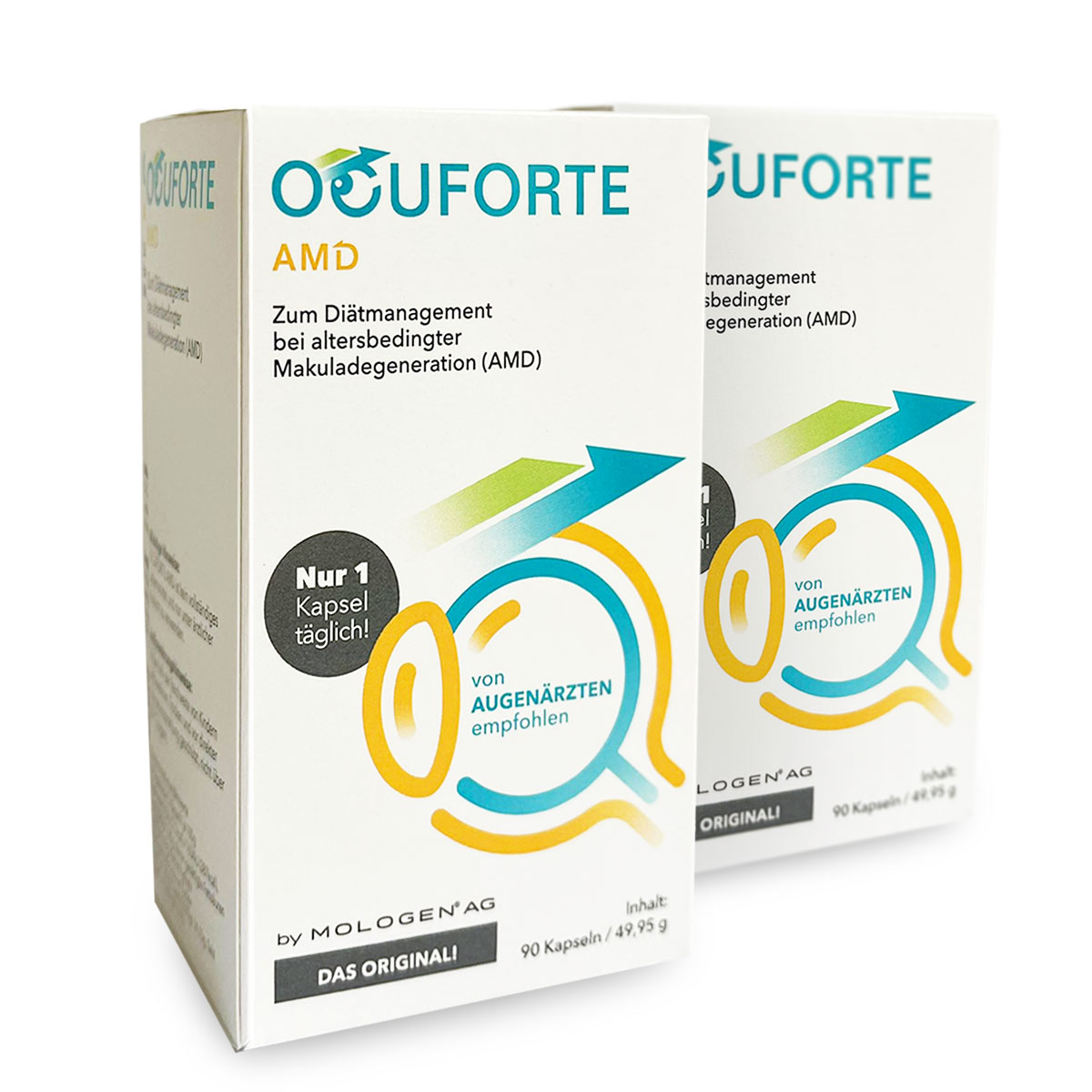
Frequently asked questions

1What is age-related macular degeneration?
Age-related macular degeneration (AMD) is a condition that affects the retina in the back of the eye, specifically targeting the macula. In this condition, the central vision of an eye is either partially or completely lost. This occurs because metabolic byproducts accumulate in the sensory cells of the macula lutea, also known as the yellow spot, and destroy them. Central vision is impaired as a result. Even if both eyes are affected, spatial orientation remains intact.
The most common form of macular degeneration is age-related macular degeneration (AMD). Initial symptoms include blurred and distorted perception in the center of the visual field. This makes reading and recognizing people increasingly difficult. In Germany, approximately four million people are affected by the disease. AMD is by far the most common cause of blindness in Germany, although even in severe cases, peripheral vision and spatial orientation are almost always preserved.
AMD is the most common cause of blindness in western industrialized countries. The incidence of AMD increases with age. It usually occurs after the age of 60. Early stages of AMD occur in one in five 70-year-olds and in 30 to 40 percent of all 85-year-olds.
The most common form of macular degeneration is age-related macular degeneration (AMD). Initial symptoms include blurred and distorted perception in the center of the visual field. This makes reading and recognizing people increasingly difficult. In Germany, approximately four million people are affected by the disease. AMD is by far the most common cause of blindness in Germany, although even in severe cases, peripheral vision and spatial orientation are almost always preserved.
AMD is the most common cause of blindness in western industrialized countries. The incidence of AMD increases with age. It usually occurs after the age of 60. Early stages of AMD occur in one in five 70-year-olds and in 30 to 40 percent of all 85-year-olds.
2How does the doctor diagnose macular degeneration?
Changes in the center of the retina can often be detected by the eye doctor before the patient notices any visual impairments.
Initially, the doctor will inquire about possible visual impairments with the patient. In addition, they perform vision tests to assess visual acuity and identify other visual disturbances. For diagnosing distorted perceptions, for example, the Amsler grid test is suitable: The patient must cover one eye and observe a printed grid from a distance of 30 to 40 centimeters. If the grid appears distorted, blurry, or unclear, this could be an indication of AMD.

The test works as follows: Cover one eye and fixate on the dot in the center with the other eye (normal reading distance, 30-40 cm). Then, test the other eye, also "one-eyed", meaning one eye is covered and the other is tested.
If you normally use reading glasses, you must wear them for the test as well!
If any of the following effects occur:
Initially, the doctor will inquire about possible visual impairments with the patient. In addition, they perform vision tests to assess visual acuity and identify other visual disturbances. For diagnosing distorted perceptions, for example, the Amsler grid test is suitable: The patient must cover one eye and observe a printed grid from a distance of 30 to 40 centimeters. If the grid appears distorted, blurry, or unclear, this could be an indication of AMD.
Amsler Grid Test

The test works as follows: Cover one eye and fixate on the dot in the center with the other eye (normal reading distance, 30-40 cm). Then, test the other eye, also "one-eyed", meaning one eye is covered and the other is tested.
If you normally use reading glasses, you must wear them for the test as well!
If any of the following effects occur:
- the dot in the center is not visible
- "holes" or gray veils
- dark or blurry spot
- unevenly sized boxes
- distorted or warped lines
Note:
The self-test with the Amsler grid complements regular eye examinations but does not replace them.3What is the prognosis of age-related macular degeneration?
Macular degeneration is a progressive condition. The speed at which vision deteriorates is unpredictable. Regular eye examinations are therefore important. In addition, every affected individual should be vigilant for signs of worsening vision.
4How can I prevent age-related macular degeneration?
The main risk factors for age-related macular degeneration are genetics and age, which cannot be controlled. However, you do not have to passively accept the loss of your vision. Alongside ophthalmological therapy, it is beneficial to provide your eyes with a diet rich in minerals and vitamins. Additionally, we recommend adopting a healthy lifestyle and avoiding additional risk factors:
- Quit smoking
- Protect yourself from strong sunlight with UV-blocking sunglasses
- Prevent high blood pressure through daily exercise (5,000-6,000 steps/approximately 1 hour)
- Shield yourself from blue light (mobile/computer screens, LEDs, etc.) by reducing your screen time or wearing glasses with a blue light filter
- Maintain a balanced and healthy diet. (Detailed dietary recommendations can be found here)
5Learn more about AMD...
Below are links to further information about age-related macular degeneration:

1What is glaucoma or green star?
The insidious aspect of green star is that it can remain unnoticed for a long time and is usually detected by chance during a routine eye examination. By the time it affects the field of vision to the extent of being noticed, it is often advanced, potentially leading to blindness over time.
Glaucoma (green star) is a vascular disease of the eye, characterized by increased intraocular pressure due to inadequate drainage of aqueous humor from the eye chambers. The causes of the disease are diverse, ranging from genetic predisposition to poor nutrition and adverse effects of medication.
Glaucoma (green star) is a vascular disease of the eye, characterized by increased intraocular pressure due to inadequate drainage of aqueous humor from the eye chambers. The causes of the disease are diverse, ranging from genetic predisposition to poor nutrition and adverse effects of medication.
2How does glaucoma (green star) develop?
A condition of glaucoma (green star) arises from a disruption in the drainage of aqueous humor from the eye chambers. This leads to an increase in intraocular pressure. As a result, there are circulation disorders, causing the optic nerve to no longer be adequately supplied with nutrients and oxygen.
3What can I do about glaucoma (green star)?
Regular eye check-ups and preventive examinations from the age of 40 help to detect glaucoma (green star) in time, as vision loss in glaucoma often occurs unnoticed over many years. Therefore, timely treatment is important. It can stop or at least slow down the progression of the disease and preserve vision.
In addition, taking specially formulated dietary supplements to support the treatment of glaucoma (green star) is recommended.
In addition, taking specially formulated dietary supplements to support the treatment of glaucoma (green star) is recommended.





